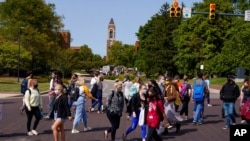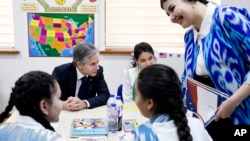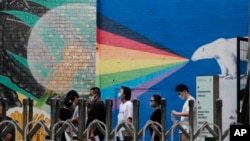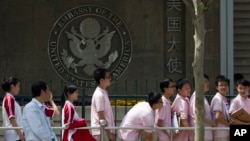Student Union
New International Student Enrollment Falls 43% in the US

COVID-19 has drastically cut international student participation in U.S. colleges and universities, punctuating three years of declining enrollment tied to costs, immigration barriers and perceived chaos in American society.
In the school year that began three months ago, new enrollment of international students dropped 43% because of COVID-19. Nearly 40,000 students — mostly incoming freshmen — have deferred enrollment at 90% of U.S. institutions to a future term.
The data were compiled and reported by the Institute for International Education and published in its annual Open Doors report about international students in the U.S. It is funded by the U.S. Department of State, which issues visas to students and visitors participating in educational or vocational training.
“The COVID-19 pandemic has impacted international student enrollment,” IIE report stated. “Many international students studying at U.S. institutions took advantage of opportunities to begin their studies remotely.”
Of the more than 1 million enrolled international students in the U.S., 20% turned to online learning this semester because of COVID-19 campus shutdowns. While some international students returned to their home countries, others are living off-campus or under strict guidelines on campus.
COVID-19 emerged on the cusp of 2020, while most university students were on winter break for Christmas and New Year’s. Students returned from points around the globe to their U.S. campuses, but by spring break in March, COVID-19 had become a pandemic and schools were struggling with how to keep their populations safe. Most campuses sent students home, shut down and moved instruction online.
Students and families pushed back on paying the high cost of tuition and fees, which can reach $70,000 per year for an undergraduate degree in the U.S., and 56% of international students pay out of pocket for their U.S. education. Many requested refunds and discounts for lack of dining and housing facilities, where universities derive the bulk of their student revenue.
The most recent data about enrollment in the semester that started this fall comes from IIE’s “fall snapshot,” which gathers data from more than 700 schools and is conducted by IIE and nine partner associations of higher education. The Open Doors data for the previous school year from August/September 2019 to May 2020 looks at a larger sample of 2,900 institutions.
There were 1,075,496 international students in the U.S., down nearly 2% from the previous year of 1,095,299. China and India again comprised more than half of the total. China sent 372,532 students to study in the U.S. while India sent 193,124.
While Chinese students increased at American schools by 0.8%, India sent 4.4% fewer students to the U.S. from year before.
At graduate schools, Chinese student numbers increased 3%. Those pursuing Optional Practical Training (OPT) increased 2%. OPT allows students to work in their field of study, typically science, technology, engineering and math (STEM). More than half of all international students pursued STEM degrees.
Among the top 25 countries to send students to the U.S., 18 showed declines from last year. After China and India, students came to the U.S. from South Korea (-4.7%), Saudi Arabia (-16.5%), Canada (-0.5%), Vietnam (-2.5%), Taiwan (1.5%), Japan (-3%), Brazil (3.8%), Mexico (-5.8%), Nigeria (2.5%), Nepal (-3.8%), Iran (-5.7%), United Kingdom (-3.5%), Turkey (-6.7%), Germany (0.6%), Bangladesh (7.1%), France (-2.8%), Kuwait (-8.9%), Indonesia (-0.7%), Spain (9.5%), Pakistan (-0.2%), Colombia (-3.4%), Malaysia (-10.4%), Venezuela (-11.7%.)
International students comprise 5.5% of the 19,720,000 students enrolled in U.S. higher education.
In last year’s Open Door report, institutions indicated some of the reasons for the decline in enrollment, including the high cost of tuition at U.S. colleges and universities, difficulty in getting visas or the insecurity of maintaining a student visa throughout a student's education, students feeling a lack of welcome in the U.S., negative political rhetoric and news of crime in the U.S.
This year, NAFSA: Association of International Educators found that the 2019-2020 international enrollment declines cost U.S. colleges and universities $1.8 billion, or 4.4% less than the previous year ($38.7 billion).
It was the first time that the dollar amount international students contribute to U.S. colleges and universities dropped in 20 years, said NAFSA.
“As the economic value decreases, we are reminded of the immense contributions that international students bring to America. We cannot afford to lose these talented individuals to a competitor country,” said NAFSA Executive Director and CEO Esther D. Brimmer.
“Our policymakers and legislative leaders must reaffirm America’s commitment to international students and scholars because our universities and colleges have never stopped doing so, and neither have our competitor countries,” she added.
Top hosting states showed declines in the number of students, (total number of students and percentage change): California (160,592, -0.7%), New York (126,911, 2.1%), Texas (77,097, -5.9%), Massachusetts (73,695, 3.7%), Illinois (51,966, -3.3%), Pennsylvania (50,070, -3.4%), Florida (46,221, 0.6%), Ohio (35,508, -4.8%), Michigan (31,408, -5.5%) and Indiana (28,136, -3.3%).
While Northeastern University in Boston moved up and University of Southern California moved down one rank this year, the top universities otherwise remained New York University (21,093), Northeastern University in Boston (17,491), University of Southern California (17,309), Columbia University (17,145), University of Illinois-Urbana-Champaign (13,962), Arizona State University (13,136), University of California-Los Angeles (11,447), University of California-San Diego (11,272), Purdue University in Indiana (11,173), Boston University (11,158), University of California-Berkeley (10,695), Pennsylvania State University (9,244), University of Washington (9,236), University of Michigan (9,000), University of Texas (8,787), University of California-Irvine (8,773), Carnegie Mellon University in Pittsburgh (8,694), University of California-Davis (7,919), Ohio State University (7,894), and Cornell University in New York (7,623).
See all News Updates of the Day
- By VOA News
International students discuss US campus culture shock

International students at De Anza College in Cupertino, California, talked about culture shock in an article in La Voz News, the student newspaper.
"It felt like a major culture shock. Everything was so different, from academics to mannerism," said a student from Mexico.
Read the full story here.
These are the most expensive schools in the US

High tuition costs along with housing and food expenses can add up for students at U.S. colleges and universities.
MSNBC looked at the most expensive schools in the country, with one costing more than $500,000 for a bachelor’s degree. (June 2024)
Uzbekistan students admitted into top US universities

Students from Uzbekistan are among the international students admitted to top colleges and universities in recent years.
Gazata.uz profiled some of the Uzbekistan students attending Harvard, Brown, Princeton and other U.S. universities. (June 2024)
- By Stella Hsu
Reports of visa checks, deportations worry Chinese STEM students in US

Geopolitical tensions and growing competition in tech between the United States and China appear to be spilling over into academia despite commitments from the world’s two biggest economies to boost people-to-people exchanges.
The United States remains the top choice for Chinese students seeking to study abroad with nearly 300,000 studying in American colleges and universities during the 2022-2023 school year. But reports of some cases that students and professors are facing extra scrutiny while passing through immigration and the deportation of others are raising concerns.
For Chen Xiaojin, a doctoral student studying semiconductor materials at a university in the Washington, D.C., metropolitan area, it has been six years since she returned to her hometown of Beijing.
At first, it was the COVID-19 pandemic that kept her from going home. But over the past two years, she has been deterred by accounts of Chinese students majoring in science and engineering being required to reapply for their visas upon returning to China.
She also says she is worried by reports over the past six months of Chinese students being deported, even at nearby Dulles Airport.
"My current research is relatively sensitive, and my boss [adviser] is getting funds from the U.S. Department of Defense, making it even more sensitive,” she told VOA. "I am afraid that I won't be able to return after I go back [to China]."
Chen says that if she did return to China, she would have to apply for a new visa.
In a report late last month, Bloomberg said it had found at least 20 Chinese students and scholars with valid visas who were deported at U.S. Customs since November and barred from reentry. The U.S. Customs and Border Protection Agency does not release relevant data.
Immigration attorney Dan Berger represented one Chinese student who was deported late last year. He tells VOA Mandarin that the student studied biological sciences at Yale University and was about to complete her doctorate.
She visited her family in China and got a new visa but was deported by customs at Dulles Airport and barred from reentering the country for five years. Berger said he did not see anything suspicious in the transcript of the conversation between the student and the customs officer.
"We have seen what seems like a pattern over the last six months of Chinese PhD students being turned around…. more than I've seen in quite a while," he said.
Matthew Brazil, a fellow at the Jamestown Foundation, said neither country seems willing to explain the situation. However, he believes that in most cases, the United States must have valid reasons for blocking visa holders from entering the country.
In some cases, the student’s background may not match what is written on the visa application. In other cases, customs agents may also find something that the State Department missed, and once they see it, they are responsible for taking action.
"I wish the Chinese side would be specific about their students who were refused entry,” he said. “The fact that both sides are mum on details and that the Chinese side is engaged with the usual angry rhetoric means that each has security concerns. And that says to me that there was good reason for the U.S. to stop these particular applicants."
Brazil also sees a connection between the entry denials and export control regulations issued by the United States in October 2022 that restrict China's ability to obtain advanced computing chips, develop and maintain supercomputers, and manufacture advanced semiconductors.
U.S. Customs and Border Protection is one of the law enforcement agencies authorized to investigate violations of export control regulations, he said.
"Beijing's intelligence agencies are known to focus attention on PRC [People's Republic of China] students and scientists headed abroad who study or work on dual-use technologies controlled under the Export Administration Act — compelling Chinese students and scientists to report on what they've learned when they return to China on holiday,” he said. “This has been true for decades."
Bill Drexel, a fellow for the Technology and National Security Program at the Center for a New American Security, said the U.S. government did find some cases where students tried to steal strategic technology for China.
"I think it would both not be surprising that they found some really questionable or incriminating evidence for some students,” he said. “It would also not be surprising if, in their hunt for really solid evidence, they also may have made some mistakes on other students.”
Drexel adds that “it’s just kind of an unfortunate fact of the time that we live in and the tactics that the CCP uses when it comes to these measures."
In a post on X in early May, U.S. ambassador to China Nicholas Burns tried to dispel concerns about visas and entry to the United States for students and scholars. In the post, he said "99.9% of Chinese students holding visas encounter no issues upon entering the United States.”
In an interview with The Wall Street Journal Monday, Burns said it is China that is making it impossible to promote people-to-people ties. Burns told the Journal that students attending events sponsored by the United States in China have been interrogated and intimidated.
He also said that since U.S. President Joe Biden and China’s leader Xi Jinping held their summit in San Francisco last year, China’s Ministry of State Security and other agencies had interfered with Chinese citizens’ participation at some 61 events.
At a regular briefing on Wednesday, Chinese Foreign Ministry spokesperson Mao Ning dismissed those accusations, saying that they did not “reflect reality" and that went against key understandings reached by both countries’ presidents in San Francisco.
“The United States, under the pretext of 'national security,' unjustifiably harasses, interrogates, and deports Chinese students in the U.S., causing them significant harm and creating a severe chilling effect,” Mao said. “The image of the United States in the minds of the Chinese people fundamentally depends on the actions of the United States itself.”
Drexel said he believes Burns’ comments about visas and students' willingness to study in the U.S. still ring true.
“On balance, it's still the case that American universities are overwhelmingly warm towards Chinese students and want them in large numbers," he said.
However, Berger, the immigration lawyer, is concerned about the chilling effect recent cases involving Chinese students could have.
"In general, we are being more careful about advising Chinese graduate students in STEM fields about traveling and letting them know that there is some small risk,” he said.
Even though the risk is small, it does seem to be real at the moment, he said.
Adrianna Zhang contributed to this report.
US federal judge blocks new regulation targeting for-profit colleges

A federal judge in Texas has blocked a regulatory provision targeting for-profit colleges that was scheduled to take effect in July 2024.
Times Higher Education reports that the rule, which would affect student loans, was challenged by for-profit institutions. (June 2024)











